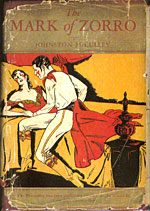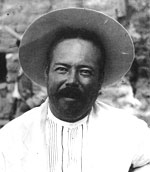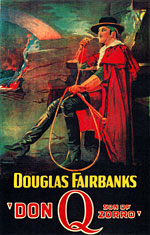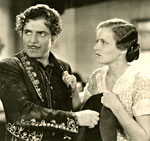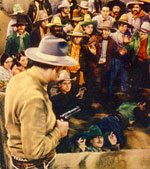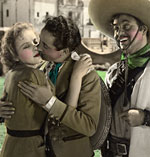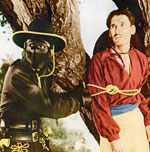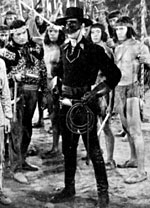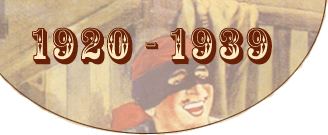

1920
The Mark of Zorro brings Johnston McCulley's swashbuckling character to the silver screen, revitalizing Douglas Fairbanks's acting career (Douglas Fairbanks Pictures Corp., dir. Fred Niblo).
In The Toll Gate, (William S. Hart Productions, directed by Lambert Hillyer) a white outlaw, played by William S. Hart, is redeemed and returns to his racial roots through the intervention of a white woman.
1921
The Avenging Arrow (Astra subsidiary of Pathé, dir. W. S. Van Dyke) popularizes the notion of females in swashbuckling leads. Ruth Roland, former "Kalem girl," produces and stars in this 15-episode serial.
1923
Pancho Villa is killed when several riflemen open fire on his 1919 Dodge Roadster as he drives through Parral, Chihuahua. Sixteen bullets pierce his body, four his head.
1925
Douglas Fairbanks wows audiences with Don Q, Son of Zorro (United Artists, dir. Donald Crisp).
Lady Robinhood (FBO, dir. Ralph Ince) builds on the popularity of Zorro, with the smoldering Evelyn Brent as the heroine.
1927
The Gay Defender (Paramount, dir. Gregory La Cava) recreates Joaquín Murrieta (played by Richard Dix) as a Robin-Hood type intent on saving California from corrupt and greedy politicians who exploit the peasantry.
1929
Warner Baxter plays a devil-may-care Mexican bandit in In Old Arizona (Fox, dirs. Raoul Walsh and Irving Cummings), a "sanitized" version of "The Caballero's Way."
The introduction of sound in movies and the perception that Latin culture and music are lively and exuberant prompt the industry to produce sound shorts such as Columbia's The Gay Caballero.
1930
Fox Studios originally intends to make The Cisco Kid but temporarily loses the rights to the Cisco character. To adjust, it produces a similar feature, The Arizona Kid (Fox, dir. Alfred Santell), using footage previously shot for Cisco. Warner Baxter stars.
1931
Fox regains the rights to the popular character and is able to release The Cisco Kid (Fox, dir. Irving Cummings), deemed the best of the Warner Baxter trio.
1932
Lasca of the Rio Grande (Universal, dir. Laemmle) stars Dorothy Burgess, who played Tonia in In Old Arizona, and Leo Carrillo as a Mexican bandit.
The Gay Caballero, based on the novel The Gay Bandit of the Border, stars George O'Brien, Conchita Montenegro, and Victor McLaglen and features a Zorro-like avenger known as "El Coyote."
1933
El Tigre de Yautepec introduces Mexican audiences to Pepito, a boy kidnapped from his family of means and reared by criminals. With complicated plot twists and a tragic ending, the story is an example of the good, good-bad, bad paradigm.
1934
Viva Villa! depicts the famed revolutionary as an ignorant yet patriotic warrior. Despite its violent content and deviation from the truth, the movie is nominated for an Academy Award in the Best Picture category.
Emilio "El Indio" Fernández makes his debut in Corazón Bandolero, a film about a bandit hero betrayed. High production values contribute to this film's becoming one of the most well-remembered features of Mexican cinema.
The Mexican film Cruz Diablo is released. Based on the capa y espada (cloak and dagger) style borrowed from Spanish literature and theater, the film features a complicated plot of false identities and nonstop action.
1935
Cinematográfica Latino Americana S. A. releases Vámonos con Pancho Villa. A somber look at the darker side of the Mexican Revolution, this film tells the story of a circle of friends who join the army of Pancho Villa. In the end only one survives.
1936
The Gay Desperado (United Artists, dir. Rouben Mamoulian) exposes audiences to a comical, musical Western, and stars Nino Martini, Leo Carrillo, and Ida Lupino.
Republic Pictures produces The Bold Caballero (Republic, dir. Wells Root), the company's first color film and the first talkie about Zorro.
In Robin Hood of El Dorado (MGM, dir. William Wellman), Warner Baxter draws on his award-winning role as the Cisco Kid to portray Joaquín Murrieta in 1850s California.
1937
Zorro Rides Again (Republic, dir. William Witney and John English), the first Zorro serial and the start of Republic's golden age of serials, stars John Carroll as James Vega, Don Diego's great-grandson, who puts on the mask to revive the tradition of fighting injustice in twelve episodes.
The Californian (Principal Productions, dir. Guz Meins) is released, based loosely on Joaquín Murrieta but with obvious similarities to the Zorro character.
1938
Errol Flynn stars in The Adventures of Robin Hood (Warner Brothers, directors Michael Curtiz and William Keighley). James Cagney was originally cast as the lead but left Warner Bros. over a salary dispute.
Warner Baxter reprises his role as Cisco in The Return of the Cisco Kid (20th Century Fox, dir. Milton Spirling). César Romero and Chris-Pin Martin play Cisco's sidekicks.
César Romero stars as Cisco for the first time in The Cisco Kid and the Lady (20th Century Fox, dir. Herbert Leeds), in which Cisco suddenly finds himself posing as a father to an infant.
